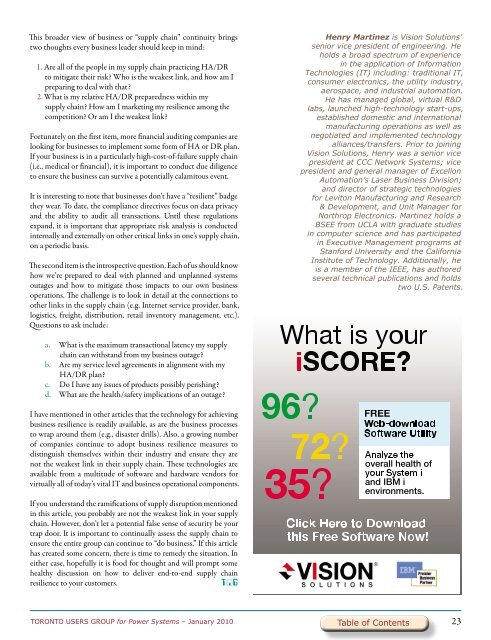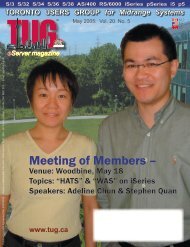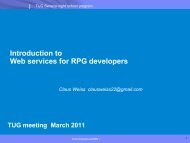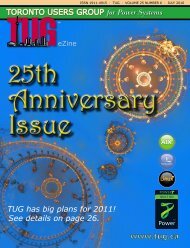Complete Magazine - PDF (5589K) - Toronto Users Group for Power ...
Complete Magazine - PDF (5589K) - Toronto Users Group for Power ...
Complete Magazine - PDF (5589K) - Toronto Users Group for Power ...
Create successful ePaper yourself
Turn your PDF publications into a flip-book with our unique Google optimized e-Paper software.
This broader view of business or “supply chain” continuity brings<br />
two thoughts every business leader should keep in mind:<br />
1. Are all of the people in my supply chain practicing HA/DR<br />
to mitigate their risk? Who is the weakest link, and how am I<br />
preparing to deal with that?<br />
2. What is my relative HA/DR preparedness within my<br />
supply chain? How am I marketing my resilience among the<br />
competition? Or am I the weakest link?<br />
Fortunately on the first item, more financial auditing companies are<br />
looking <strong>for</strong> businesses to implement some <strong>for</strong>m of HA or DR plan.<br />
If your business is in a particularly high-cost-of-failure supply chain<br />
(i.e., medical or financial), it is important to conduct due diligence<br />
to ensure the business can survive a potentially calamitous event.<br />
It is interesting to note that businesses don’t have a “resilient” badge<br />
they wear. To date, the compliance directives focus on data privacy<br />
and the ability to audit all transactions. Until these regulations<br />
expand, it is important that appropriate risk analysis is conducted<br />
internally and externally on other critical links in one’s supply chain,<br />
on a periodic basis.<br />
The second item is the introspective question. Each of us should know<br />
how we’re prepared to deal with planned and unplanned systems<br />
outages and how to mitigate those impacts to our own business<br />
operations. The challenge is to look in detail at the connections to<br />
other links in the supply chain (e.g. Internet service provider, bank,<br />
logistics, freight, distribution, retail inventory management, etc.).<br />
Questions to ask include:<br />
a. What is the maximum transactional latency my supply<br />
chain can withstand from my business outage?<br />
b. Are my service level agreements in alignment with my<br />
HA/DR plan?<br />
c. Do I have any issues of products possibly perishing?<br />
d. What are the health/safety implications of an outage?<br />
I have mentioned in other articles that the technology <strong>for</strong> achieving<br />
business resilience is readily available, as are the business processes<br />
to wrap around them (e.g., disaster drills). Also, a growing number<br />
of companies continue to adopt business resilience measures to<br />
distinguish themselves within their industry and ensure they are<br />
not the weakest link in their supply chain. These technologies are<br />
available from a multitude of software and hardware vendors <strong>for</strong><br />
virtually all of today’s vital IT and business operational components.<br />
If you understand the ramifications of supply disruption mentioned<br />
in this article, you probably are not the weakest link in your supply<br />
chain. However, don’t let a potential false sense of security be your<br />
trap door. It is important to continually assess the supply chain to<br />
ensure the entire group can continue to “do business.” If this article<br />
has created some concern, there is time to remedy the situation. In<br />
either case, hopefully it is food <strong>for</strong> thought and will prompt some<br />
healthy discussion on how to deliver end-to-end supply chain<br />
resilience to your customers. T�G<br />
TORONTO USERS GROUP <strong>for</strong> <strong>Power</strong> Systems – January 2010<br />
Henry Martinez is Vision Solutions’<br />
senior vice president of engineering. He<br />
holds a broad spectrum of experience<br />
in the application of In<strong>for</strong>mation<br />
Technologies (IT) including: traditional IT,<br />
consumer electronics, the utility industry,<br />
aerospace, and industrial automation.<br />
He has managed global, virtual R&D<br />
labs, launched high-technology start-ups,<br />
established domestic and international<br />
manufacturing operations as well as<br />
negotiated and implemented technology<br />
alliances/transfers. Prior to joining<br />
Vision Solutions, Henry was a senior vice<br />
president at CCC Network Systems; vice<br />
president and general manager of Excellon<br />
Automation’s Laser Business Division;<br />
and director of strategic technologies<br />
<strong>for</strong> Leviton Manufacturing and Research<br />
& Development, and Unit Manager <strong>for</strong><br />
Northrop Electronics. Martinez holds a<br />
BSEE from UCLA with graduate studies<br />
in computer science and has participated<br />
in Executive Management programs at<br />
Stan<strong>for</strong>d University and the Cali<strong>for</strong>nia<br />
Institute of Technology. Additionally, he<br />
is a member of the IEEE, has authored<br />
several technical publications and holds<br />
two U.S. Patents.<br />
Table of Contents<br />
23





